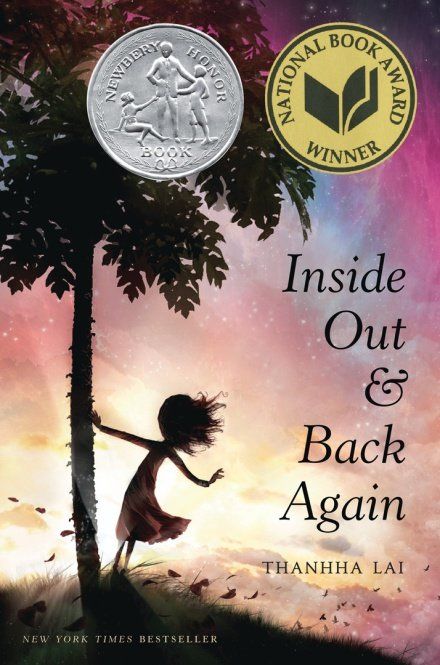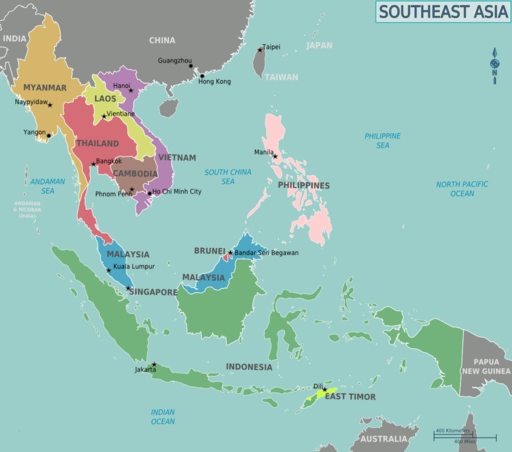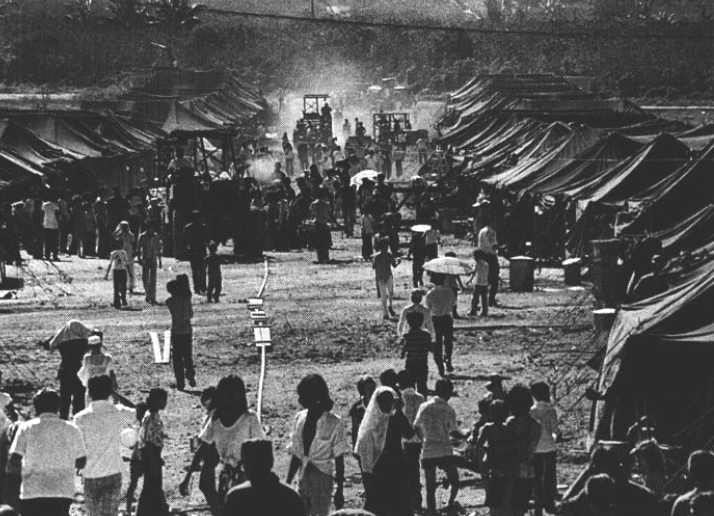Fresh from our book club reading of "A Long Walk to Water", we took up another immigrant experience in "Inside Out and Back Again". This book was inspired by the author's experience fleeing Vietnam after the Fall of Saigon and immigrating to Alabama.
The book is written in free verse, which may discourage some students - asking them to read it aloud helps them to 'hear' the author's voice. There are four sections in the book which make for natural divisions; however, the third section is much longer and in retrospect we should have discussed it over two sessions.
General Resources
- Classroom Bookshelf has literary analysis questions, links to videos about Vietnam, and bibliography for further reading.
- Duke Classroom Bookshelf has literary analysis questions and charts, as well as suggestions for deeper reading.
- Teaching Books has author interviews and links to other discussion guides. This site is well curated and worth checking for other popular YA books.
Pre-reading: Historical Context
Students at late elementary/early middle may not have the historical or geographical context so we started with understanding Vietnam in 1975. First, we looked for Vietnam on a map of Southeast Asia.
Then we looked for Vietnam on an older map, such as this one from Morton's Elementary Geography, published in 1900. Students were surprised that its shape was different, and it was labeled French Indochina.
This gave us the opportunity to discuss that Vietnam has had a complex history. It has had periods of independence, but also years of occupation by China, Portugal, France and more recently Japan during World War II. After World War II ended, the French returned but some Vietnamese wanted to be independent. This ended up splitting the nation in two – a group in the North declared independence in 1945. They fought and defeated the French in 1954, causing those who still supported the French to flee to South Vietnam. Students may be interested to know that during this time, 600,000 to 1,000,000 Vietnamese moved south and approximately 100,000 Viet Minh from the south moved north.
To sum up, we used a map of divided Vietnam and referred back to it during discussions.
North Vietnam: Independence, supported by Communists (China,
Russia). Capital was Hanoi. Led by Ho Chi Minh.
South Vietnam: Supported first by France, then USA. Capital was Saigon.
Then, we turned to the title page of Section I and asked them to find the setting (place and time) of the first diary entry - Saigon, 1975.
At the time the diary begins, there has been continuous fighting for almost 20 years between North and South. America had previously tried to help South Vietnam, but pulled out in 1973. Smelling victory, the North armies moves closer to Saigon..
Section I: Saigon
The more pictures you can show, the better students can understand Ha's
perspective of Saigon in 1975: vibrant and full of beloved memories
despite the shadow of the encroaching North. Flickr has picture galleries of Saigon (pre-1975): Gallery 1 and Gallery 2. Ask students to look for specific items such as the sugar cane juicer, grilled squid and Tet celebrations. You may also want to show pictures of a cyclo (such as this one) as mentioned in the book. Students can also spot French influence on Vietnam such as in its vocabulary (tout de suit) and cuisine (pate chaud, page 22). In fact the Vietnamese word for coffee (Cà phê) sounds like the French (café), Vietnamese coffee is well known and Vietnam is the world's second largest producer of coffee after Brazil.
At the same time, the author hints at trouble in the society at large. See if students can find the following instances:
- Inflation and economic pressure (pages 14-17)
- Bombs are getting closer (page 18)
- Shadow of communism ("I lived in the North", page 45): This is a good opportunity to explain communism's ideology (class equality through eliminating private property) and how property was forcibly taken from land owners through land reform.You can also contrast Marx's worldview that society's problems are external (hence redistribution is the key to a perfect society) vs. the Bible's view that man's problems are internal (Romans 3) and can be solved only in Christ. Linda Hobar's "Mystery of History Volume IV explains this lesson beautifully'.
Furthermore, the author mentions personal problems, most notably the father's absence as explained in pages 12, 13 and 59 (when they burn all personal items so nothing will be left to incriminate him). A picture of an altar and its relationship to ancestor worship may help students visually.
The pace of the book picks up as the family decides to leave Saigon. As the family had ties to the South Vietnamese navy, they have passage on a naval ship together with hundreds who swarm onboard. This picture of the Pioneer Contender from Naval History gives an example of the crowded conditions. It is while they are at sea that they learn about the Fall of Saigon, including the news of the tanks rolling through the palace gates.
Section II: At Sea
Although the plight of the Vietnamese refugees gathered much attention in the 70s, the author deliberately kept this section short as she was too young to understand much, and her experience was easier than most. (Her later book, Butterfly Yellow, describes trauma which would be hard for elementary school).
To set the context, we started with a map showing the neighboring countries where refugees fled.
These countries had refugee camps set up where the refugees could stay until they could go to countries accepting them, e.g. USA, Canada, UK, France, Australia.
Getting to camp itself was fraught with danger. The author was on a ship, but many fled on small boats that were unsuited for long journeys. Ask students to consider what problems may arise ("One Engine", page 87-88) lists some: being stranded, running out of food/water, being caught by the Viet Cong. Other dangers not listed in the book: pirates, typhoons, boat breaking down, diseases that would spread quickly in the crowded conditions.
When they reached a country with a refugee camp, that country might not want to accept them, e.g. the camps might be full. The worst thing would to be rejected and towed back out to sea – it was like a death sentence since many of the old boats would eventually break down. If the students' parents approve, the first few minutes of this "60 Minutes" broadcast capture the tension of arrival.
Returning to the author's experience, she mentions that a US ship tows them out to Guam (“A Kiss”, page 91). This seems quite far, so it's shown on the map above as “Possible route”. We explained to the students that Guam is a US Territory, its status and proximity to Asia made it a logical place for a US refugee camp. The Guam camp would house 110,000 refugees. That’s a fraction of the 800,000 Vietnamese refugees estimated to have fled during that time (and some estimate that 200,000 to 400,000 i.e. ¼ to ½ of them died en route). To house that many people, they used some old barracks and set up several makeshift tents (“Tent City, page 96), NYTimes has an article on "Operation New Life" describing how the camp was set up at short notice.
One common attribute of refugee camps is that the refugees usually may not work. Although they were given food and necessities, they didn’t have money to buy things and often they didn’t have the freedom to just leave the camp. Sometimes, local people would come to sell items, which wasn’t officially approved, and is called a “black market”. In “Amethyst Ring” (page 104), the mother has to make a hard choice – should she sell the ring her husband gave her so she can make new clothes for the children? In “Nuoc Mam” (page 100), the author cheers because someone sent cases of fish sauce to the camp. These make for interesting reflections: that one can be safe, yet not 'at home'.
Some students were intrigued about fish sauce. According to Wandering Chopsticks, it’s made by "fish ..(like) herring and sardines. The fish were salted and left for three days to extract juices. Some of the juice was saved and left to ferment in the sun, while the rest of the juice was pressed with the fish. The two juices were mixed together and left to ferment for three months or longer. Solid parts were strained out."

Another detail: The author mentions a flag lowering ceremony in "Last Respects" (page 85). We showed students the flags of South Vietnam and the current flag of Vietnam. The flag of South Vietnam is yellow with three red stripes that represent North, Central and South Vietnam regions; the current flag is red (which symbolizes bloodshed, revolution and struggle) with a 5 pointed star that represents the five main classes in Vietnamese society (workers, peasants, soldiers, intellectuals, and businessmen). Seeing the different flags helped students understand they might see the South Vietnam flag in some places. For example, just 3 years ago, San Jose banned the display of the Communist/Socialist Vietnam flag on city flagpoles because San Jose has over 100,000 Vietnamese and it represents oppression to many.
The author then describes the period of choosing - the mother chooses America, even though they have no relatives and they don't speak much English, because of educational opportunities. Unfortunately they are not chosen for sponsorship, possibly because their family is too large. Finally, their mother hears people prefer "Christians" and in one stroke changes their faith on their application. This part generated a lot of reaction. Was it right for them to change from Buddhists to Christians? Are all faiths really the same ? Was it right for sponsors to prefer Christians? If we are honest with ourselves, don't we prefer being with other believers too?
Galatians 6:10 So then, as we have opportunity, let us do good to everyone, and especially to those who are of the household of faith.We can be certain on this: pray hard before we undertake a venture like sponsorship – if God leads us to invite people from a different faith, be aware it can be very difficult. We may have to say No to some of their wishes, but don’t hold back our help. Pray for opportunities to tell them about God, but don’t treat them differently because if they don’t respond. And keep looking out for ways to help Christians too – Christians are actually heavily persecuted in many places.
Section III Alabama (pages 115-234)
Again, to set the context we looked at pictures from Alabama in the 1970s from Only in Your State and the Alabama State Archives. Among them was a striking photo of the space shuttle Enterprise being delivered to Marshall Space Center, a reminder of the center's contribution to history (it provided the large Saturn rockets used by the Apollo lunar missions in the 60s, as well as the Lunar Rover and Hubble Telescope) At the same time, we wanted to clarify the time period. Mention Montgomery, AL and most think of the Civil Rights movement, Martin Luther King and Rosa Parks. That was an important period but it happened in the 1960s, 10 years before Thanghha arrived. Still, change is slow, e.g. George Wallace, who had opposed desegregation, was still governing Alabama during 1975.Section III captured the feeling of culture shock that so many
immigrants feel. Although the diary is chronological, we found it easier
to group and discuss her experiences.
- Food: This was a fun guessing game. Can students guess what the following are from Thanghha’s description?
- Pink sausage snuggled inside bread shaped like a corncob (p144)
- Fruit in bite sizes, drowning in sweet white fluff (p166)
- Cookies with drops of chocolate small as rain (p166)
- Flat, round, pan-fried cakes floating in syrup (p166)
- White meat sandwich (p183)
- Crunchy curly things sprinkled with salt (p183)
- Jiggly, colorful food we don’t eat (p193)
- Culture Bumps
- Chicken is like “bread in water” (p119)
- It is quiet and vast (p122)
- Nobody washes clothes for a living here, they use a machine (p125)
- Sewing machine goes fast here (electric vs pedal), Mother comes home with bandaged fingers
- English : several instances of frustration, e.g. “S”, plurals.
- School (p143): No place for medium skin tones
- School (p156): This is what dumb feels like. I used to know fractions and purifying water, now I read 1..20 and they clap.
We also asked students to gather the reactions of those around Thanhha's family across the spectrum, you could see children mostly changing over time as they became accustomed to the family; sadly, not much was said about the adults' changing. Questions: Why did these people react the way they did? Where did they learn to treat others this way?
- Baptism (page 169): The family were told they would be treated better if they were baptized. This again generated a lot of discussion - all of us understanding that this was not Christ-like behavior.
- Thanhha's comment: "I would sometimes choose war in Saigon over peace in AL (p194-195)". The author mentioned this was due to a lack of control over her environment and that Alabama in the 1970s was very different.
- Learning that Mrs Washington’s son had died in the Vietnam War (p200): Of all the people in the neighborhood, she had the most reason to dislike Vietnamese. Although we don't agree with all her actions (e.g. giving a prayer gong), in this crucial aspect she is the most Christ-like.
- The papaya motif returns in Dec 20, 21("Christmas"). The author initially rejects the sweet papaya strips which do not taste like the fresh papaya she remembers from Saigon but Mother tells her to adapt; after soaking them for hours she tries them and admits, “Not the same, but not bad at all”.
Section IV: From Now On (page 237-262)
Flannel dress/nightgown incident: The girl who questioned Ha (“Don’t you know flannel is only for nightgowns and sheets?”) probably did not intend to be mean. There are things we just know because we grew up here, some interesting ones include: Americans really love their pets to the point of giving them birthday parties, in Japan counting on the hand is first additive then subtractive. More importantly though, Thanhha now has friends “Pem” and “Sssttivan” who defend her (What do I care what you wear, it looks like a dress to me), and she has grown in shrugging off these misunderstandings (“I pretended not to care, then no one cared, so I didn’t really care").
Gone/Truly Gone/Eternal Peace (page 248-252): Mother loses amethyst stone that Father gave her, “your father is truly gone”. They can’t hold a funeral for their father – they don’t even have an official notice that he is dead, just the symbolic loss of his ring. Buddhists believe that chanting eases a soul’s transition to leave the body, and go on to the next cycle of rebirth (Buddhist belief) . Christians believe differently, yet how should we react if we meet Ha in her grief?
Ending: "I hope to fly-kick, not to kick anyone but to fly". Ha is no longer fighting with her new home. As we reflect on Ha's experiences, we can see ourselves reflected in the characters. We know we should be like Missis Washington, but we are often like Pink Face Boy. When we meet someone we just don't understand, let's remember Acts 17:26 - God brought them into this place/time for His reason, and we are to treat them so that they want to know our Savior.
Acts 17:26 : (God) made from one man every nation of mankind to live on all the face of the earth, having determined allotted periods and the boundaries of their dwelling place, that they should seek God, and perhaps feel their way toward him and find him.










No comments:
Post a Comment